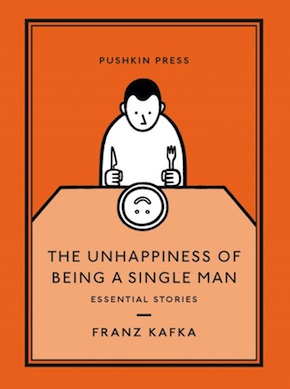A hunger artist
by Franz KafkaIn the past few decades public interest in the art of fasting has drastically declined. While it used to be very profitable to put on big, stand-alone exhibitions, doing so today would be completely impossible. It was another time. Back then, the whole city would get caught up in what the hunger artist was doing; the audience would grow and grow as the fast went on; everyone wanted to see him at least once a day; in the latter stages, you’d get fans who wanted to sit in front of the small cage from dawn till dusk; there were also viewings at night, with the effect heightened by flaming torches; on sunny days, the cage would be carried outside and children would be brought to see the hunger artist; whereas for adults he was often only a bit of fun, whom they went to see because it was fashionable, the children gazed at him in amazement, their mouths open, holding each other’s hands just in case something happened, while he, disdaining even a chair, sat on a scattering of straw, pale, in a black vest through which you could see his ribs sticking out, sometimes nodding politely, sometimes answering questions with an effortful smile, even stretching his arm out through the bars to let them feel how emaciated he was, then sinking back into himself, paying attention to nothing, not even the clock, which was the only furniture in his cage and struck the hours that were so important to him, but only staring into space with his eyes almost shut, and now and then sipping water from a tiny glass just to keep his lips wet.
As well as the spectators, who came and went, there were also warders chosen by the public – strangely enough, they were usually butchers – whose job it was to watch the hunger artist day and night, always three at a time, so that he couldn’t secretly take a bite of food. But it was only a formality introduced to reassure the audiences, because those involved knew full well that during a fast the artist would never, under no circumstances, not even under duress, have eaten even the tiniest snack; the honour of his art forbade it. It’s true that not every warder could understand that; you sometimes got groups of warders who’d do a very lax job of watching the artist at night, intentionally sitting together in a remote corner of the room and engrossing themselves in a game of cards with the obvious intention of allowing the artist to gulp some small morsel that they imagined he’d be able to produce from somewhere. Nothing was more painful to the hunger artist than this kind of warder; they lowered his spirits; they made the hunger incredibly hard to bear; sometimes he gathered enough strength to sing during these watches, for as long as he could, to show these people how wrong they were to be suspicious of him. But it hardly helped; they just wondered about how he’d learnt to sing and eat at the same time. He much preferred the warders who sat up close against the bars, who weren’t satisfied by the dim lighting in the hall and fixed him with electric torches that the impresario provided. The harsh light didn’t bother him at all, he couldn’t fall properly asleep anyway, and he could always doze a little, regardless of how bright or what time it was, even when the hall was packed and noisy. With warders like these he was very willing to pass the night without any sleep; he was ready to joke around with them, to tell them stories from his nomadic life or to listen to their stories, anything to keep them awake and show them over and over again that there was nothing edible in his cage and that he was fasting as none of them ever could have. But he was at his happiest when morning came and they were brought an enormous breakfast, billed to him, which they threw themselves on with the appetite of healthy men who’d spent a long night at their posts. A few people managed to convince themselves that these breakfasts were an attempt to unduly influence the warders, but that really was going too far, and when they were asked whether they’d like to prove the point by taking the night watch themselves, without any breakfast, they made themselves scarce, albeit without giving up their scepticism.
Perhaps he was only so emaciated because of his dissatisfaction with himself. He alone knew something that even the most obsessive fans didn’t, namely how easy it was to fast. It was the easiest thing in the world.”
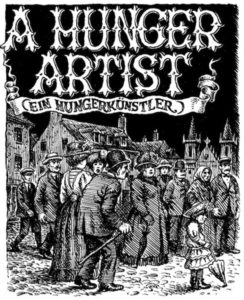
Title page for an abridged version of the story in Robert Crumb and David Zane Mairowitz’ Kafka (Fantagraphics Books, 2007)
These, however, were merely some of the suspicions that were inseparable from the art of fasting. After all, no single person could spend every day and night uninterruptedly watching the artist, so no one could tell with his own eyes whether the artist really was fasting uninterruptedly, that is, flawlessly; only the hunger artist was in a position to know that; he himself was the only spectator who could have been completely satisfied by his fast. But there were other considerations that meant satisfaction always eluded him. In fact, it was perhaps not even the fasting itself that emaciated him so much that some people had to stay away from the performances, to their regret, because they couldn’t bear to look at him; perhaps he was only so emaciated because of his dissatisfaction with himself. He alone knew something that even the most obsessive fans didn’t, namely how easy it was to fast. It was the easiest thing in the world. He didn’t try to hide it, but no one believed him; at best they thought him modest, but usually they assumed that he was looking for publicity or even that he was a cheat who found fasting easy because he’d found some means of making it easy, and now even had the chutzpah to more or less admit it. He had to put up with all this, had got used to it over the years, but on the inside this dissatisfaction was always gnawing at him and he had never, in no fast – he insisted on having a certificate stating this made out – he had never willingly left the cage. The maximum fasting time had been set by the impresario at forty days; he never let it go on beyond that, not even in the capital cities, and for good reason. Experience showed that, for about forty days, ever increasing publicity could whip up a city’s interest to greater and greater heights, but after that the audiences would start to dwindle and there would be a marked tailing off in the show’s popularity; of course there might be small differences between cities and countries, but as a rule it was true that forty days was the maximum. So on the fortieth day the door to the flower-bedecked cage was opened, a rapturous audience packed the amphitheatre, a brass band played, two doctors went into the cage to perform the necessary tests on the hunger artist, the results were relayed to the spectators through a megaphone, and last of all came two young ladies, who were very happy to have won the raffle and now wanted to lead the hunger artist out of the cage and down a couple of steps to a little table where a carefully prepared recovery meal had been laid out. And in that moment the hunger artist always resisted. Although he would willingly put his bony arms into the helpfully outstretched hands of the two ladies bending down to him, he didn’t want to get up. Why stop now after forty days of hunger? He could have held out much longer, indefinitely; why stop when he was at the peak, not even yet at the peak, of his fast? Why did they want to deny him the fame of fasting longer, of becoming not just the greatest hunger artist of all time, which he probably already was, but also of surpassing himself and carrying on into a performance that was beyond human understanding – because he could feel no limits to his capacity for hunger. Why did these crowds, who claimed to admire him so much, have so little patience with him; if he could hold out for longer, why shouldn’t they? Also he was tired and sitting comfortably on the straw, and they wanted him to get up and walk over to this meal, the mere thought of which made him feel nauseous, something he only suppressed, with difficulty, out of consideration for the ladies. And he looked up into the eyes of the ladies who seemed so friendly but were in reality so cruel, and shook his over-heavy head on his weak neck. But then happened what always happened. The impresario came and silently – the music made talking impossible – raised his arms above the hunger artist, as if inviting the heavens to look at his work here on the straw, this pitiable martyr, something the hunger artist certainly was, albeit in a quite different sense; he clasped the hunger artist around his thin waist, taking exaggerated care to show everyone what a fragile object he was handling, and – subtly shaking him a little so that the hunger artist’s legs and upper body swayed loosely back and forth – handed him over to the young ladies, who were now deathly pale. After that, the hunger artist acquiesced to everything; his head lay on his chest as if it had rolled there and inexplicably stopped; his torso had been hollowed out; his legs pressed themselves together at the knees as if in self-preservation, dragging along the ground as though it wasn’t real and the real ground was somewhere below it; and the whole, very small, weight of his body was deposited on one of the young ladies, who, appealing for help and hyperventilating – this was not how she’d imagined her honorary task – at first stretched out her neck as far as possible to keep at least her face from touching the hunger artist, then, when that didn’t work and her luckier companion didn’t help, made do with reaching out, trembling, to the artist’s hand and carrying that little packet of bones ahead of herself, the first young lady burst into tears, to the delighted laughter of the amphitheatre, and had to be relieved by an attendant who’d long been standing by for that very purpose. Then came the meal, a few scraps of which the impresario pushed into the hunger artist, who was in a half-sleep bordering on unconsciousness, while the impresario kept up an entertaining patter that was intended to distract attention from the state the artist was in; finally a toast was drunk to the audience, supposedly at the whispered suggestion of the artist; the band confirmed everything with a mighty flourish, people went their separate ways, and nobody had any right to be dissatisfied with what he’d seen, nobody, only the hunger artist, always only him.
It sometimes happened, especially if he was deep into a fasting period, that the hunger artist would react with a fit of rage, frightening the audience by rattling at his cage like an animal.”
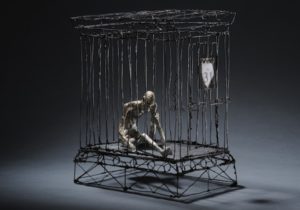
Ein Hungerkünstler wire sculpture by Martin Senn, 2003 martinsenn.ch
With regular short rest periods, he was able to live this way for many years, in apparent glory, feted by the world, but nevertheless usually in a gloomy mood that became steadily gloomier because nobody would take it seriously. After all, what could they have comforted him with? What more could he wish for? And if occasionally he met some good-natured person who sympathized and tried to explain that his sadness was probably a consequence of hunger, it sometimes happened, especially if he was deep into a fasting period, that the hunger artist would react with a fit of rage, frightening the audience by rattling at his cage like an animal. But the impresario had a punishment he liked to employ for these outbursts. He apologized to the assembled public on the artist’s behalf and admitted that nothing could excuse his behaviour except the irritability caused by hunger, something well-fed people could hardly understand; then he came on to the claims made by the hunger artist – which, after all, also needed an explanation – that he would be able to fast for far longer than he did; the impresario praised the noble endeavour, the goodwill, the great self-denial that was certainly bound up in that claim; but then he refuted it simply enough, by showing photographs – which were also on sale – of the artist on his fortieth fast day, in bed, so enfeebled he was almost extinguished. This twisting of the facts, which was well known to the hunger artist but always unnerved him all over again, was too much for him. The consequences of prematurely ending the fast were being presented as the reason for doing so! Against that unreason, to fight against this world of unreason, was impossible. Every time this came up he would listen greedily at the bars, in good faith, but when the photographs appeared he would let go of the bars, sink back into the straw with a sigh, and the reassured spectators could come and view him again.
When the people who witnessed these scenes thought back a couple of years later, they often found that they no longer understood what they’d been doing there. Because by then the collapse in public interest mentioned above had taken place; it happened suddenly; there may have been deeper reasons for it, but who cared enough to dig around for them; in any case, one day the pampered hunger artist found that the pleasure-seeking crowds had abandoned him and now preferred to go to other kinds of performance. Once again the impresario rushed him through half of Europe, to see whether here and there they might still find a flicker of the old interest; all in vain; as if in some secret pact, audiences everywhere had developed a downright aversion to performance fasting. Of course things like that couldn’t change overnight, and in retrospect they remembered several warning signs that had been insufficiently heeded or addressed amid the intoxication of fame, but it was too late to do anything about it now. Although it was certain that the art of fasting’s time would one day come again, that was no comfort to those living through this moment. What was the hunger artist supposed to do? He, who’d been celebrated by thousands, couldn’t start displaying himself in a booth at local fairs, and as for taking up another profession, the artist was not only too old, he was above all too fanatically devoted to his hunger. So he said goodbye to the impresario, who’d been his companion in an unparalleled career, and had himself taken on by a travelling circus; to spare his own feelings, he didn’t even look at the terms of the contract.
A big circus with its myriad of people and animals and apparatuses, all complementing and offsetting one another, can find a use for anybody at any time, even a hunger artist, on appropriately modest terms of course, and moreover in this particular case it was not just the hunger artist himself who’d been hired, but also his famous old name; given the unique nature of this art form, which made no concessions to advancing age, you couldn’t have said that a veteran artist past his prime was retreating into a quiet circus job; on the contrary, the hunger artist assured them that he would fast just as well as he ever had, which was entirely credible, and went so far as to claim that, if he was allowed to have his way – something that was promised out of hand – he would astonish the world as he’d never been able to before, a claim that, in view of the fashions of the day, which the hunger artist forgot in his enthusiasm, elicited no more than a smile from the experts.
Overall, however, even the hunger artist didn’t lose sight of the real state of affairs and took it as read that his cage wouldn’t be placed in the centre of the ring as a star attraction, but was found a home outside, in an actually very easily accessible spot just next to the menagerie. Big, colourfully painted signs framed the cage and announced what could be seen inside. In the intervals in the main show, when the audience streamed out to see the animals, it was almost inevitable that they passed by the hunger artist and paused there for a moment. They might have stayed there longer had it not been that the passage was narrow and that those pushing on from the back of the crowd, who didn’t understand this delay on the way to the eagerly anticipated menagerie, made any slower, quieter viewing impossible. That was why the viewing times, which he naturally looked forward to since they were the purpose of his life, also made him tremble. At first he could hardly wait for the intervals in the main show; he’d been exhilarated as he prepared to face the onrushing masses, but all too soon – even his most obstinate, almost conscious self-deception couldn’t withstand what he experienced – he became convinced that if you categorized these spectators by what they wanted to see, they were all, always and without exception, visitors to the menagerie. The first sight of them, from a distance, remained the most pleasant. When they had got up close, he was surrounded by a racket of shouting and swearing between the two groups that always formed, those – who soon became almost more painful to the hunger artist – who wanted to have a good look at him, not out of understanding, but on a whim or out of spite; and those who truly only wanted to get to the menagerie. Once the main bulk of them had gone by, there were always a few stragglers, who had nothing to prevent them stopping as long as they liked, but they hurried past with long strides, barely glancing sideways, to make sure they saw the animals in time.
People grew used to the strangeness of a circus trying to attract attention with a hunger artist in this day and age, and with that his fate was sealed.”
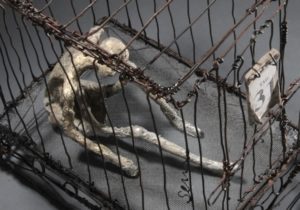
Ein Hungerkünstler wire sculpture by Martin Senn (detail), 2003 martinsenn.ch
All too rarely did a father come past with his children, point his finger at the artist, explain what was going on, tell them how it had been years ago, when he’d gone to similar but incomparably grander performances; the children hadn’t been prepared by school or life to really understand – after all, what was fasting to them? – but in their bright, curious eyes he saw a sign of new, more favourable, times to come. Perhaps, the hunger artist then sometimes said to himself, it would be better after all if he wasn’t positioned so near the menagerie. His being there made the choice between him and the animals too easy for people, not to mention that the smell of the stalls, the animals’ restlessness at night, the slabs of raw meat being brought to the carnivores and the uproar at feeding time all upset and depressed him. But he didn’t dare take a grievance to the management; at the end of the day, he owed the animals the crowds of visitors who trooped past him and among whom one or two of the right sort might appear; and who knew where the management would stick him if he reminded them that he existed and that, strictly speaking, he was an obstacle on the way to the menagerie.
A small obstacle though, an ever smaller obstacle. People grew used to the strangeness of a circus trying to attract attention with a hunger artist in this day and age, and with that his fate was sealed. He was free to fast as hard as he could, and did so, but nothing now could save him, and the public simply walked past. Try explaining the art of hunger! If someone doesn’t feel it, you can’t make them understand. The lovely signs on his cage grew dirty and illegible; they were torn down and no one thought to replace them; the little board displaying the number of days he’d fasted – which at first had been diligently updated every morning – had now long remained unchanged, because after a few weeks the attendants grew bored of even that small job; and so although the hunger artist fasted just as he’d dreamt of doing, and although he effortlessly succeeded in holding out ever longer, just as he’d predicted, no one counted the days, no one, not even the hunger artist himself, knew exactly how much he’d achieved, and his heart grew heavy. Now when someone idling by happened to stop, to make fun of the number on the board and talk about it being a con, it was tantamount to the stupidest lie that indifference and malice could have concocted, because the hunger artist didn’t cheat, he did his work honestly, but the world cheated him of his reward.
But many days again went by and this, too, came to an end. A supervisor noticed the cage and asked the attendants why this useful piece of equipment had been left standing around with nothing but some rotten straw inside it; no one could say, until someone looked at the board with the numbers and remembered the hunger artist. They poked through the straw with poles and found the artist underneath. “You’re still fasting?” asked the supervisor. “When are you finally going to stop?”
“Forgive me, all of you,” whispered the hunger artist; only the supervisor, whose ear was to the bars, could hear him.
“Of course,” said the supervisor, putting a finger to his temple to show his staff what condition the artist was in. “We forgive you.”
“I always wanted you to admire my fasting,” said the hunger artist.
“And we do admire it,” the supervisor said obligingly.
“But you shouldn’t admire it,” said the hunger artist.
“All right, then we don’t admire it,” said the supervisor, “but why shouldn’t we admire it?”
“Because I have to fast, I can’t help it,” said the hunger artist.
“How about that,” said the supervisor. “So why can’t you help it?”
“Because,” said the hunger artist, and he lifted his head a little, pursing his lips as if for a kiss, so he could speak right into the supervisor’s ear and make sure nothing was lost, “I couldn’t find a meal I would have liked to eat. If I’d found one, believe me, I wouldn’t have made a fuss, I’d have eaten till I was full, just like you or anyone else.” Those were his last words, but in his broken eyes there remained the firm, albeit no longer proud, conviction that he would go on fasting.
“Get this cleared up!” said the supervisor, and they buried the hunger artist together with the straw. In the cage they put a young panther. Even the most stolid attendants felt the relief of seeing this wild animal throwing himself around the long-deserted cage. He lacked for nothing. The keepers brought him the food he liked as a matter of course; he didn’t even seem to miss his freedom; his glorious body, endowed almost to bursting with all it needed, seemed to carry its own freedom within itself; it seemed to lurk somewhere in the panther’s jaws; and the joy of life steamed out of his mouth with such force that the spectators felt they could barely hold their ground against it. But they braced themselves, crowded around the cage and never wanted to leave.
from The Unhappiness of Being a Single Man: Essential Stories (Pushkin Press, £12)
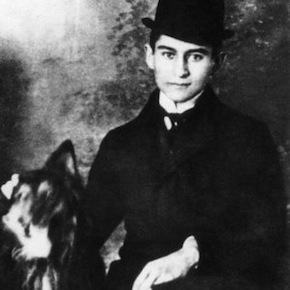
Franz Kafka (1883–1924) was born to Jewish parents in Prague, and wrote in German. He published only a few story collections and individual stories in literary magazines during his lifetime. The rest of his work was published posthumously. He is now considered one of the most influential authors of the twentieth century. The Unhappiness of Being a Single Man: Essential Stories, selected and translated by Alexander Starritt, is published in paperback by Pushkin Press.
Read more
Right: Franz Kafka and dog, c. 1905 © Pictorial Press Ltd/Alamy Stock Photo
Alexander Starritt is a writer, translator and journalist living in London. The author of The Beast (Apollo, 2017), his writing has been shortlisted for the Paris Literary Prize and he has contributed articles to the Times Literary Supplement, the Spectator and the Mail on Sunday.
@StarrittAlex

